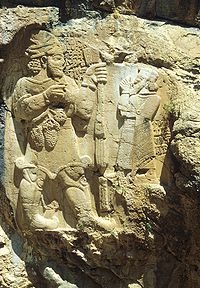Ereğli, Konya
Ereğli | |
|---|---|
District | |
 Konya Ereğli Korean Park | |
 Location of Ereğli, Konya within Turkey. | |
| Coordinates: 37°31′N 34°03′E / 37.517°N 34.050°E | |
| Country | |
| Province | Konya |
| Government | |
| • Mayor | Özkan Özgüven(AKP) |
| Area | |
| • District | 2,560.32 km2 (988.55 sq mi) |
| Elevation | 1,043 m (3,422 ft) |
| Population | |
| • Urban | Template:Turkey district populations |
| • District | Template:Turkey district populations |
| Time zone | UTC+2 (EET) |
| • Summer (DST) | UTC+3 (EEST) |
| Postal code | 42xxx |
| Area code | 0332 |
| Licence plate | 42 |
| Website | www.konya-eregli.gov.tr |
Ereğli is a city and district of Konya Province in the Central Anatolia region of Turkey. According to 2009 census, the population of the district is 135,008 of which 95,056 live in the town of Ereğli.[2][3][4]
History
The ancient town of Heraclea Cybistra (Ηράκλεια Κυβίστρα in Ancient Greek) was located here, and gave its name (Heracles) to the modern town. The town had some importance in Hellenistic times owing to its position near the point where the road to the Gülek Pass (Cilician Gates) enters the hills. It lay in the way of armies and was more than once sacked by the Arab invaders of Asia Minor (AD 805 and 832). During the Crusade of 1101 it was the scene of a failed battle of 15,000 men led by William II, Count of Nevers, which left the Crusaders weak en route to Antioch.[5] It became Turkish (Seljuk) in the 11th century.
Ereğli is also known for being the first capital of the Karaman Beylik founded by Nure Sufi Bey. The Karaman state was renowned for being a consistent nuisance to Ottoman dominance in Anatolia, being one of the few Anatolian beyliks to retain sovereignty well past Fatih Sultan Mehmet's conquest of Istanbul. It was also the first political entity in Anatolia to proclaim Turkish as an official language. In 1553, upon return from a campaign in Persia, Suleiman the Magnificent had his son, Şehzade Mustafa, killed in the Ereğli valley where the Ottoman army was stationed. Modern Ereğli had grown from a large village to a town since the railway reached it from Konya and Karaman in 1904; and it has now hotels and thriving businesses.
Archaeology

Three hours’ ride south is the famous "Hittite" rock relief of a lynx, representing a king (probably of neighbouring Tyana) adoring a god. This was the first "Hittite" monument discovered in modern times (early 18th century, by the Swede Otter, an emissary of Louis XIV).
Eregli may be the location of the Hittite town of Hupisna (Ḫupišna), where the goddess Ḫuwaššanna was worshipped. She was linked with Gazbaba, a Mesopotamian love goddess also connected with Inanna.
In the early Iron Age, Hupisna also was a neo-Hittite polity in the land of Tabal. Two kings of Hupisna are known from the Assyrian sources: Puḫamme (c. 837 BC) and Urimme (c. 738 BC).[6][7]
Transportation

Ereğli Gar is the railway station of the town. Once served by several train lines that have destinations to Istanbul, İzmir and Konya, the station is currently served by Mainline / Toros Ekspresi only, which connects Ereğli to Adana and Karaman.[citation needed]
Notable residents
- Nimet Çubukçu, current Minister of Education of Turkey.
- Ali Talip Özdemir, former head of the Motherland Party (ANAP)
- Şehzade Mustafa, heir to the Ottoman throne who was killed in the Ereğli valley
- Volkan Ş. Ediger (born 1953, is a scientist, writer and bureaucrat
International relations
Twin towns — Sister cities
Ereğli is twinned with:
See also
- Çayhan
- Kwangjin Park, a park in Ereğli.
- Zengen
Notes
- ^ "Area of regions (including lakes), km²". Regional Statistics Database. Turkish Statistical Institute. 2002. Retrieved 2013-03-05.
- ^ "Archived copy". Archived from the original on 2015-09-20. Retrieved 2016-12-20.
{{cite web}}: CS1 maint: archived copy as title (link) - ^ Turkish Statistical Institute. "Census 2000, Key statistics for urban areas of Turkey" (in Turkish). Archived from the original (XLS) on 2007-09-27. Retrieved 2008-03-25.
- ^ GeoHive. "Statistical information on Turkey's administrative units". Retrieved 2008-03-25.
- ^ Richard, Jean (16 September 1999). The Crusades, C. 1071-c. 1291. Cambridge University Press. p. 73. ISBN 0-521-62566-1.
- ^ Trevor Bryce: The World of the Neo-Hittite Kingdoms; A Political and Military History. Oxford, New York 2012, pp. 153, 271.
- ^ Christian Marek, Peter Frei: Geschichte Kleinasiens in der Antike. München 2010, p. 802.
- ^ "Twinnings" (PDF). Central Union of Municipalities & Communities of Greece. Archived from the original (PDF) on 2016-01-15. Retrieved 2013-08-25.
References
- Falling Rain Genomics, Inc. "Geographical information on Ereğli, Turkey". Retrieved 2008-03-25.
External links
- District governor's official website (in Turkish)
- District Municipality's official website (in Turkish)



